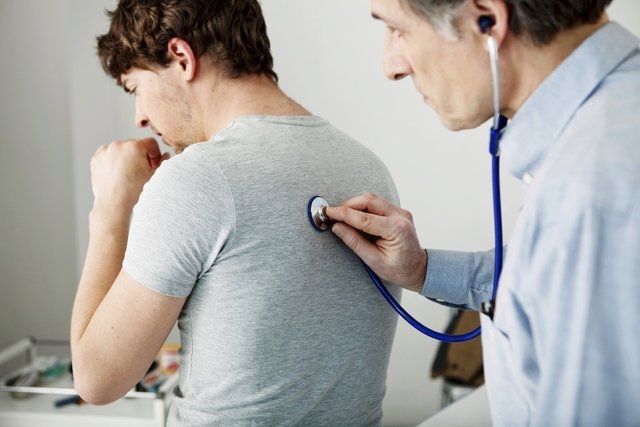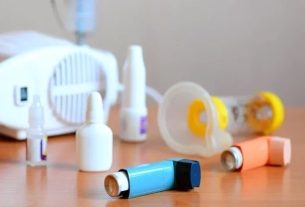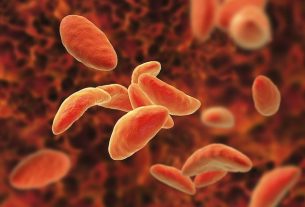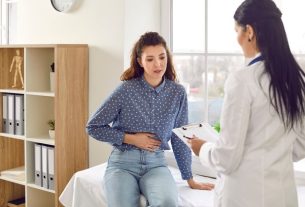COPD (chronic obstructive pulmonary disease) is a group of respiratory diseases, such as chronic bronchitis and pulmonary emphysema, that block the airways and make breathing difficult.
The main cause of COPD is smoking, as the smoke and other substances present in cigarettes damage the tissue of the respiratory tract, leading to symptoms such as shortness of breath, coughing with mucus and wheezing when breathing, for example. Learn about other diseases caused by cigarettes.
The treatment of chronic obstructive pulmonary disease must be indicated by a pulmonologist and varies according to the disease that caused COPD, and can be done with the use of medication, surgery or physiotherapy, in addition to being recommended to stop smoking.

Main symptoms of COPD
The main symptoms of COPD are:
- Constant cough;
- Clear, white, yellow or greenish phlegm;
- Rapid and panting breathing;
- Sensation of noise or wheezing in the chest when breathing;
- Clearing throat;
- Shortness of breath during exertion;
- Production of a lot of phlegm, especially in the morning;
- Tiredness;
- Weight loss.
The initial symptoms of COPD can be mild and even mistaken for a common cold. However, as the disease progresses, symptoms worsen and become more constant due to progressive damage to the lungs.
Furthermore, people with COPD may have a weakened immune system, making them more likely to have colds, flu or respiratory infections more frequently, which can increase difficulty breathing and cause greater phlegm production, a situation that is called “COPD exacerbated.”
Online symptom test
To find out your chances of having chronic obstructive pulmonary disease (COPD), please select the symptoms you present:
How to confirm the diagnosis
The diagnosis of COPD is made by a pulmonologist, who evaluates the signs and symptoms presented, the health history and performs some physical examinations, such as checking blood pressure and listening to the heart and lungs.
If you would like an evaluation by a pulmonologist, schedule an appointment in the nearest region:
Taking care of your health has never been easier!
In addition, the doctor may also order some tests to complement the diagnosis, such as a chest X-ray; computed tomography; blood tests, such as arterial blood gas analysis; and spirometry, an exam that shows the degree of obstruction of the airways and the amount of air the person can breathe. Find out how spirometry is performed.
These tests help the doctor confirm the diagnosis of COPD, but they can also be used to identify other diseases that may be causing the symptoms, such as asthma or heart failure, for example.
Possible causes of COPD
COPD occurs when the bronchi or bronchioles in the lungs become inflamed and close, making it difficult for air to pass through and breathe. The main causes of COPD are:
- Smoking;
- Asma;
- Chronic bronchitis;
- Genetic changes in the lungs.
The main cause of COPD is smoking, although this disease can also affect people who have never smoked, due to exposure to other people’s cigarette smoke. However, some risk factors can increase the chances of contracting COPD, such as prolonged exposure to dust, smoke from wood stoves and chemicals.
How the treatment is carried out
COPD treatment relieves symptoms, improves quality of life and prevents complications. Typically includes:
1. Quit smoking
To treat COPD, it is essential to stop smoking to prevent the disease from worsening, thus avoiding a decrease in respiratory capacity and possible complications, such as respiratory infections and pulmonary hypertension, for example.
Although it is difficult for many people to quit smoking, your doctor may recommend the use of medicines that help treat nicotine dependence, reducing anxiety or irritability. Additionally, support groups or psychotherapy can also help you quit smoking. See the best strategies for quitting smoking.
2. Use of medicines
The medications that the pulmonologist may recommend vary depending on the symptoms presented and the progression of the disease, but are usually:
- Inhaled bronchodilators, such as salbutamol, formoterol or ipratropium bromide, which help open the bronchi and facilitate breathing;
- Oral corticosteroids, such as prednisone, or inhaler bombs, such as fluticasone or budesonide, for example, which reduce inflammation and irritation in the lungs;
- Phosphodiesterase inhibitors, such as roflumilast, which helps reduce inflammation and relax the muscles in the airways, making breathing easier;
- Theophylline, medicine that helps relax the muscles in the airways, improve breathing and prevent complications from COPD;
- Mucolytics, such as acetylcysteine or carbocisteine, as they act to make phlegm more liquid, facilitating its elimination, relieving coughs;
- Antibiotics, such as azithromycin or amoxicillin, which help treat respiratory infections, such as bronchitis, pneumonia or flu, thus preventing COPD symptoms from worsening.
The use of any of these remedies should only be done under the guidance and supervision of a pulmonologist and with specific doses for each person.
3. Respiratory physiotherapy
Respiratory physiotherapy helps to improve breathing capacity and quality of life for people with COPD. The objective of this treatment is to help rehabilitate breathing, thus reducing symptoms, medication doses and the need for hospitalization.
4. Proper nutrition
Proper nutrition is essential to maintain an adequate weight, preventing COPD symptoms from worsening. The diet also helps to improve breathing, as the metabolism of nutrients consumes oxygen and releases carbon dioxide in the body. This becomes especially important in COPD, as this disease makes gas exchange in the lungs difficult, making it difficult to eliminate carbon dioxide.
During COPD it is important to prioritize foods rich in fiber, such as fruits, fresh vegetables, and whole grains, such as brown rice and whole grain pasta; lean proteins, such as fish, eggs and chicken; and healthy fats such as avocado, olive oil and nuts.
It is recommended to avoid the consumption of simple carbohydrates, such as sugar, biscuits, candy, sugary drinks, jams and cakes, for example. Furthermore, it is important to avoid foods that increase the production of gases that can make breathing difficult, such as carbonated drinks, beans, broccoli, cauliflower, Brussels sprouts, corn, lentils, soybeans, leeks and peas.
It is important to always consult a nutritionist before starting a COPD diet, to create a dietary plan adapted to individual needs, as some people may need to lose weight, while others need to gain weight during treatment.
5. Oxygen therapy
Oxygen therapy is a treatment that increases oxygen levels in the blood, which can be reduced due to the damage caused by COPD, reaching very low levels. This treatment may be recommended by the doctor to be done during a few hours of the day or continuously, depending on each case.
There are several types of oxygen therapy that can be recommended by a pulmonologist according to each person’s needs. Check out the main types of oxygen therapy.
6. Surgery
Surgery may be recommended by a pulmonologist in some cases of very severe COPD caused by pulmonary emphysema, when treatment with medication is not effective in controlling the symptoms of the disease.
This surgery is performed to remove small parts of the damaged lung, allowing the healthy parts to expand, making breathing easier and improving the person’s quality of life.
7. Lung transplant
Lung transplantation can be done if other treatment options are not effective in controlling COPD symptoms, as it allows you to improve your ability to breathe and be more active.
However, lung transplantation is the last treatment option for COPD, as it presents several risks, especially rejection of the transplanted organ. In addition, the person may need to take immunosuppressant medications for life. Find out what a lung transplant is like and what recovery is like.
Care during treatment
Some important precautions during COPD treatment are:
- Take the medicine at times established by the doctor;
- Take vaccines, such as influenza or pneumococcal, as indicated by the doctor, to avoid lung infections;
- Maintain adequate weight, avoiding overweight and underweight;
- Stay in a comfortable position when lying down, to facilitate breathing, preferring to leave the bed inclined if there is difficulty breathing;
- Do physical exercises recommended by your doctorrespecting your own limitations, so that shortness of breath does not become too intense;
- Clear the airways about an hour before a meal;
- Avoid alcoholic drinks, such as beer, wine and sparkling wine;
- Drink plenty of fluids, such as water, teas and coconut water, which improve hydration and fluidize secretions, helping to eliminate them;
- Avoid places with a lot of dust, strong-smelling products, hairspray or perfumes, which can cause irritation or inflammation in the lungs and worsen symptoms, leading to exacerbations.
Furthermore, it is important to keep a card in your bag or wallet with information that the person has COPD, the medications they use and the doses, as well as contact details in case of emergencies and COPD exacerbation crises.
Possible complications
The complications that COPD can cause are frequent respiratory infections, including the common cold, flu or pneumonia, but also pulmonary hypertension, heart disease or lung cancer.
Difficulty breathing and carrying out daily activities can also contribute to the development of depression or anxiety.

Sign up for our newsletter and stay up to date with exclusive news
that can transform your routine!
Warning: Undefined array key "title" in /home/storelat/public_html/wp-content/plugins/link-whisper-premium/templates/frontend/related-posts.php on line 12
Warning: Undefined array key "title_tag" in /home/storelat/public_html/wp-content/plugins/link-whisper-premium/templates/frontend/related-posts.php on line 13



